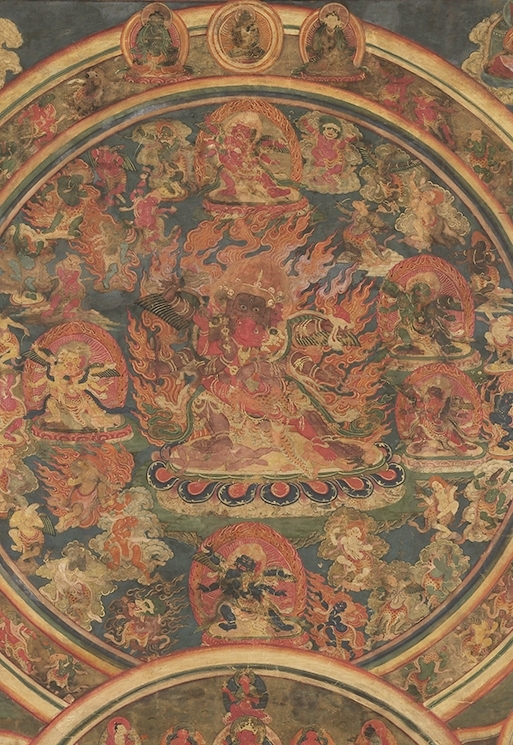
At the moment of death, according to Buddhist belief, we have an opportunity to attain an enlightened state of mind. However, our own karma brings up various visions, including terrifying ones. If we do not recognize them as mere projections of our own mind, whose essence is that of reality itself, we may not escape from the cycle of death and rebirth.
This painting depicts the deities described in a 14th-century text “The Peaceful and Wrathful Deities, The Profound Teachings of Self-liberated Wisdom Mind” and the famous “Liberation upon Hearing in the Intermediate State” (known in the West as the Tibetan Book of the Dead). These teachings (terma) were discovered by the treasure revealer Karma Lingpa.
These images illustrate a structured and vivid experience between death and rebirth. The bardo teachings encourage those who reach this state to realize the true nature of the visions and free oneself from the cycle of birth and death. If the peaceful deities are not recognized, then visions of the wrathful deities appear (shown here), but at this stage it becomes more difficult to recognize their true nature due to their fearsome appearance. This detail depicts a host of the wrathful deities and terrifying forms of peaceful deities, covered in flames, holding weapons and skull-cups of blood, in union with equally wrathful consorts, trampling corpses underfoot. Yet their wrath is directed not against the practitioner, but against their negative emotions. This creates an opportunity for liberation if one can recognize their true nature.
The teachings of the bardo allow practitioners to prepare and train their minds for this future eventuality. Often ritual specialists read these instructions to the deceased as the means of guiding them through this difficult process of transitioning to future existence.
57 3/4 x 44 1/4 x 2 1/4 in.
C2006.66.17, HAR 505
- https://dev.rubinmuseum.org/images/content/6612/c2006.66.17__zoom.jpg
- https://dev.rubinmuseum.org/images/content/6612/c2006.66.17__zoom.jpg

